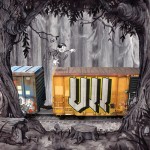When Blitzen Trapper first came to the fore in 2007, with the release of Wild Mountain Nation, the band had already been in operation as a recording entity for four years with two releases prior to that. All the same their visibility on a national scale escalated incrementally from that point, with key support from Pitchfork online magazine, especially.
Before that third album had even hit the streets the Trappers had already signed on with Sub Pop to record a fourth, Furr, which they released in 2008. They made two more records for Sub Pop before leaving last year. Last spring on the band label LidKerCow, they re-released their eponymous first album on 180 gram vinyl, some versions of which contain five extra tracks (!). This is their first release for Vagrant Records.
So, that is to say that the band is now ten years old studio wise, and VII is their (as the title might suggest) seventh LP. Seven albums is quite an achievement for an eccentric little band from Salem—Typhoon also originally hale from Salem too. Perhaps there’s something in the Willamette down there. Whatever the case, Blitzen Trapper have managed to survive and thrive while remaining relatively anonymous in Portland.
The band’s career arc seems to closely resemble that of the Decemberists or the Shins (maybe on a somewhat smaller scale) in that they went national before they even had a chance to really go local. Esperanza Spalding erupted out of a vacuum, of course.
Some in the national press have lately remarked that the band has shucked its “Northwest roots” (however one might try to define those) in favor of embracing a more universal pan-Americana sound. But anyone familiar with Blitzen Trapper know that the evolution for the current species of the band began in the swamps of their earliest recorded efforts and are easily traced. So all that talk is a load of editorial hooey.
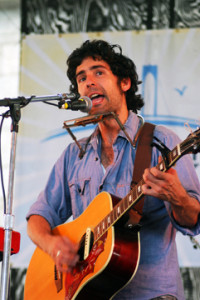
Leader, singer/songwriter Eric Earley is renowned for his homespun, campfire canticles. Though he denies having been exposed much to popular music in his formative years, and admits to being impervious to most forms of media, trying to toss a lasso around his musical inspirations would require quite a lengthy rope. But Americana would certainly be a logical point from which to start pitching the twine. Still, the field of influence widens obtusely from there.
Perhaps it would be more simple to list where Blitzen Trapper do not go musically than where they do go (if, at times, only briefly). I have never heard them play classical music, jazz or showtunes. No world music. So far no musique concrète or dodecaphony. Uh… They don’t really do death metal.
To an extent, the band have become comfortable with themselves, with their musical niche. That much is true. Although there are always instances within any Blitzen Trapper production where one can find indications of experimentation. This complaint of “complacency,” which I have seen registered around, can be made of just about every rock band. Very few are able to move very far from their comfort zones. Some do better than others. But how far did REM get in thirty years, for example?

Blitzen Trapper have been lumped by some as mere ‘70s rehashbacks, which misses whole decades of intrinsic musical influence. So, I’m not sure anybody really knows anything about the band (including yours truly). Perhaps they serve as the perfect musical mirror. You hear your own eclectic tastes in what they play—a little something for everybody. I don’t necessarily agree with all the references others hear in their music, but I’ll defend to the expiration date of my driver’s license their right to hear it that way. Here’s what I hear.
The band tosses in the proverbial musical kitchen sink on the first cut, “Fell the Chill.” It’s a standard issue Earley fable, something about wandering in the woods with a rusty pail and stumbling across a woman in her underwear. Just the usual BT modus operandi. Vocally, Eric renders his usual Bob Dylan-like growl. But here a fine, gritty texture in his voice recalls all the best things about the late JJ Cale.
A cool, incongruent synth figure punctuates the turns, occasional harmonica wails for emphasis, while prickly country Tele and what sounds like a Clavinet mingle in a very unique melange. The not unexpected banjo peeks in and out in the hoedown near the end. Gifted engineer Gregg Williams makes Brian Koch’s drums sound like rocket fire—which makes sense since he drums with Quarterflash, as well as having served as engineer on many great recordings by top local bands. Ubiquitous musician/producer/engineer Danny O’Hanlon (a member of the Minus 5 aggregation among many other enterprises) is also on board to lend his expertise.
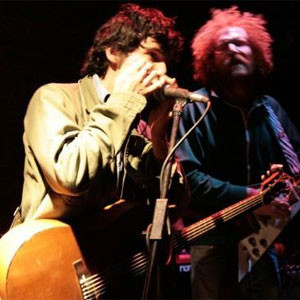
A faint funk underpinning in the rhythm section drives the cheery “Shine On.” Eric Earley doesn’t really have much of a voice, but that being said, these guys do a lot with what he’s got. Here it’s as if Steve Goodman or Lyle Lovett were fronting the Black Keys. It’s a Column A/Column B thing with this band. Choose one style from each column and throw them together. It is true however that the Trappers often do create additional Columns of influence from which to draw on any given song.
This one has a feel as if it were performed by an Americana blues version of KC and the Sunshine Band. Ms. Liz Vice contributes soulful backup vocals. Slippery slide guitar textures take the song in a completely different referential direction. But that’s what it’s all about. A really fiery harp solo drives the blues supply side of this equation. Blitzen Trapper at their best! Ziggin’ and a zaggin’.
The parabolic quality of Earley’s songs is brought into clear relief with “Ever Loved Once,” wherein the band render one of what he calls “those songs I keep writing over and over again, with all its regrets and tragic lost love.” The lyric is matched with an urgent vocal melody driven at first by acoustic guitar, Neil Youngy harmonica and guest Paul Brainard’s (Richmond Fontaine, among many) familiarly mournful pedal steel guitar. Spry banjo and “Witchy Woman” era Eagles harmonies kick in windily after the catchy chorus. Classic Blitzen Trapper.
Here’s an observation as to why Blitzen’s music is misperceived by the rest of the nation. Most of the country has no idea what Oregon really is. They think it’s Portlandia and hippies and the Willamette Valley (Go Ducks! Go Beavs!). They don’t know what a hick state this truly is at its core. Look. I was raised here. I have lived among them. I am one. It’s a state full of hicks. Just about everything south of Eugene and east of the Cascades. You got it. Own it.

So when the music aficionados of the world opine that the band must be breaking free of it’s so called “Oregon roots,” they do so not fully understanding that Americana, folk, bluegrass and especially country music, in all its various forms and formats, has always been rampant in this part of the world, they fail to acknowledge that Blitzen Trapper’s real growth has come in its ability to express those particular idiosyncrasies within the true Oregon lifestyle. They haven’t moved from Salem to Appalaichia or Nashville. They’ve moved to John Day.
“Thirsty Man” is a marvelous confection filled with juicy little details. A soft samba nylon-string guitar vamps hairpins while tinkly, harpsicordic keys, staccato rhythm guitar, and hummingbird mandolin flit among flares of distorted guitar and siren harp calls. All this going on, yet the arrangement is as wide open as the Oregon high prairie—another testament to expert production (Earley and bassist Michael Van Pelt) and facile engineering.
The wool sweater of Earley’s vocal is inspired not only by Dylan and John Lennon (who started sounding like Dylan by late 1964), there is the second ‘70s layer that includes Joe Egan and Gerry Rafferty in Stealer’s Wheel (“Stuck in the Middle With You”), and Don Henley of the young Eagles. Later, the Dylan and JJ Cale (which begat latter-day Clapton) features wove themselves into Mark Knopfler of Dire Straits. From that point thirty years hence, among the myriad permutations of the above, we arrive at Eric Earley.
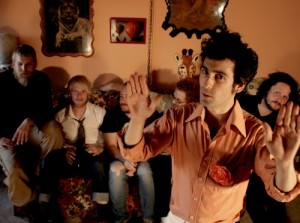 The song itself rousing, gospel infused at its soul, with a stirring chorus of biblical proportions. “I let you slip away like water right through my hands/Baby your love’s like rain in the desert to a thirsty man.” A blistering psychedelic organ solo, worthy of David Cohen of Country Joe and the Fish, or Ray Manzerak of the Doors follows. This is Blitzen Trapper at the top of their game mining three or four veins simultaneously—sluicing gold. That’s how they roll.
The song itself rousing, gospel infused at its soul, with a stirring chorus of biblical proportions. “I let you slip away like water right through my hands/Baby your love’s like rain in the desert to a thirsty man.” A blistering psychedelic organ solo, worthy of David Cohen of Country Joe and the Fish, or Ray Manzerak of the Doors follows. This is Blitzen Trapper at the top of their game mining three or four veins simultaneously—sluicing gold. That’s how they roll.
The mythic biblicality of “Valley of Death” maintains that lyrical reference point—perhaps from a bit more of a drunken perspective. Over a sparse, barren arrangement, Eric spins his tale, similar instrumental elements as its predecessor charting wide-open terrain. From there we dissolve into “Oregon Geography,” which might best be described as Beck’s “Loser” strained through the film Deliverance. Banjo over drum samples and rapped poetry. From there we river through the banjo stilted drum rapids of “Neck Tatts, Cadillacs.”
An exotic string loop is accompanied by classic wah-wah guitar phrases to set an Isaac Hayes mood for “Earth (The Fever Called Love),” from which the band immediately depart at the top of the verse. From there they head into more Mellow Gold era Beck, with Eric rapping over dobro and banjo straight from old Rocky Top. The middle break heads off in a completely different direction, but only briefly. And the ending digs into that soul vibe even more deeply with squawking sax nailing it down.
“Drive On Up” changes gears, capturing some of the same spunky momentum as “God & Suicide” from Furr. But here there is more of a Black Crowes meet Joe Tex attitude punctuated by wiry Clavinet, a squirty synth riff, sassy saxes, and gritty guitar: all resembling one another in the mix. Great interplay between harp and guitar in the solo. Nicely done.
Serving as the requisite Blitzen Trapper rewrite of the Dead’s “Casey Jones” for this outing, “Heart Attack” covers poppier ground while sticking to the primarily acoustic flavor of this album. Eric vocalizes a sweet, McCartney-like falsetto in the lead role not heard elsewhere. After the oddball solo section is concluded, I could be convinced this was a latter-day Badfinger song. Though this song’s chorus is not among the band’s best.

Maybe the most interesting spin of the dozen is the smoky “Faces of You,” which harkens vocally to JJ Cale or Mark Knopfler on the first Dire Straits album. So does the snaky groove, reminiscent of the Zombies’ “She’s Not There” mashed with the Doors’ “Riders on the Storm” motivated by Van Pelt’s rolling bassline. A memorable chorus sticks like gum to the bottom of the mind’s shoe. On an album that at times sounds a little like a band in search of a direction, this is one definitely worth continuing to explore—maybe, in some cases, without the exuberant solo. Different for Blitzen Trapper.
Finally, with “Don’t Be a Stranger” the band goes all California hippie country in the tradition of the Byrds, the Burritos, the Eagles and the Dead, et al. Merry banjo and the chuckling slap of electric guitar vie for the aural spotlight backing Earley’s capoed acoustic guitar and Priney Dylanesque vocal presentation. High vocal harmonies in the chorus mirror not only the Dead, but fall in the tradition other country rock bands from the formative years, such as Poco, the Eagles, Pure Prairie League and Firefall.
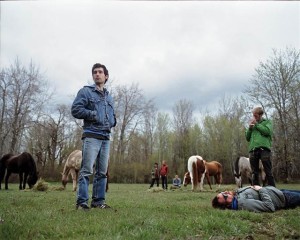
Blitzen Trapper have evolved in an atypical way over the past six years and the three albums between Wild Mountain Nation and this one. In essence they have devolved. If we were to view this geographically, it would be as if the little rock outfit (with Americana jam band roots) moved east from their home in the Willamette Valley. About as far east as La Grande. In other words, they have devolved from an off-kilter Oregon rock band into an off-kilter Oregona band as Pickathon ready as they come.
And while some may mourn the band they left behind, there is yet still much to love about Blitzen Trapper. For one thing the sound quality of this record is impeccable and it is readily apparent that a lot of care and attention to detail went into the composition of these tracks. And for just that reason, any “label” one might be inclined to attach to the band is inapplicable.
They have one foot in the ‘60s and “Rainy Day Women” period Dylan, another on hallowed Dead ground; one in the ‘70s and the dawning of “country rock,” and yet one more in the desolate “Western” territory that is home to lonesome cowboys like Richmond Fontaine. That’s four feet—like a coyote.
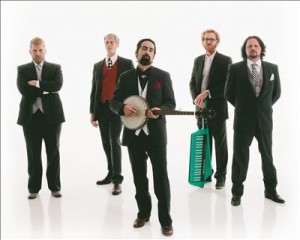
Fans of the old rock rendition of Blitzen Trapper of the Oughts probably don’t have much use for this one. Though the band is no less experimental, their experiments are fewer, if no less jarringly unexpected. But the truth of the matter is that they rarely rock anymore, instead yield to the sort of contemplation one is prone to over the course of a decade of living life.
Then again, Neil Young is free to make these zigzag transitions at will, so it’s difficult to question Blitzen Trapper’s artistic decisions. What they are doing now, they are doing quite well. But there is the sense of a band treading water here, looking for a new musical destination, while exploring uncharted directions, but only tentatively—as if marking territory rather than establishing new ground.
Eric Earley has never been the most profound of poets, though he bestows a homespun discernment that lends his tales authenticity, as well as often achieving a similar windswept context as Willy Vlautin for Richmond Fontaine. Earley’s lyrics are perhaps a bit more magical or fantastical in context. And, as an instrument, his voice is no more nor less capable than all those to whom he has been compared, with a skill for expression perhaps greater than the actual words themselves.
 This isn’t a great album. But several songs, possibly half of them or more, are very solid. The musicianship is, as always, subtly spectacular throughout. The guests added for the project help to extend the paths of exploration, if only incrementally. They add texture and hue. And that flair for the immediacy of aural tactility and color, as much as anything, is what distinguishes Blitzen Trapper from the run of the mill.
This isn’t a great album. But several songs, possibly half of them or more, are very solid. The musicianship is, as always, subtly spectacular throughout. The guests added for the project help to extend the paths of exploration, if only incrementally. They add texture and hue. And that flair for the immediacy of aural tactility and color, as much as anything, is what distinguishes Blitzen Trapper from the run of the mill.


